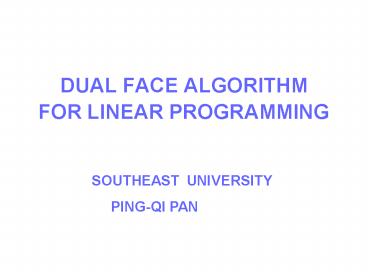DUAL FACE ALGORITHM FOR LINEAR PROGRAMMING - PowerPoint PPT Presentation
Title:
DUAL FACE ALGORITHM FOR LINEAR PROGRAMMING
Description:
dual face, until reaching a dual optimal face along ... Affine-scaling pivot algorithm (submitted) 1.2. Basic Idea : Moving from face to face. ... – PowerPoint PPT presentation
Number of Views:42
Avg rating:3.0/5.0
Title: DUAL FACE ALGORITHM FOR LINEAR PROGRAMMING
1
DUAL FACE ALGORITHM FOR LINEAR PROGRAMMING
SOUTHEAST UNIVERSITY PING-QI
PAN
2
-
- Abstract
- The proposed algorithm proceeds from dual face
to - dual face, until reaching a dual optimal face
along - with a pair of dual and primal optimal
solutions, - compared with the simplex algorithm, which moves
- from vertex to vertex. It computes the search
- direction as an orthogonal projection of the
dual - objective gradient onto a relevant null space.
In each - iteration, it solves a single small triangular
system, - compared with four triangular systems handled by
- the simplex algorithm. We report preliminary but
- favorable computational results with a set of
- standard Netlib test problems.
3
- Introduction
- 1.1. The State of the Art.
- Simplex algorithm (G. B. Dantzig 1947)
- Ellipsoid algorithm ( Khachiyan 1979)
- Interior-point algorithm ( Karmarkar 1984)
- Pans work
- The obtuse-angle principle(1990)
- Bisection simplex algorithm (1991)
- The most-obtuse-angle rules(1997)
- Deficient basis projective pivot algorithms
(1997-) - Nested pricing, Largest-distance pricing (2008-)
- Affine-scaling pivot algorithm (submitted)
1.2. Basic Idea Moving from face to face.
4
- 1.3. Model.
- We are concerned with the linear
- programming (LP) problem in the standard form
- The dual problem
5
1.4. Model Reformulation. Program (1.2) can
be transformed to
6
2. Dual search direction and line search.
7
- Dual face associated with B
- According Subprogram
2.1. dual search direction
8
(No Transcript)
9
- The solution can be obtained by solving the
upper triangular system alone
2.3. Line search
10
2.4. Contracting dual face and updating the
Cholesky factor.
3.Optimality test.
11
- 3.1. Expanding dual face and updating the
- Cholesky factor.
4. The dual face algorithm
12
(No Transcript)
13
An attractive feature in each iteration, it
solves a single smaller triangular system.
4.1. More features.
Any expansion iteration must be followed by a
contraction iteration. The latter is called
accompanying (contraction) iteration.
14
If a component (excluding one that just be set to
zero in a preceding expansion iteration) of
is zero, it is termed degenerate.
5. Phase-1
Auxiliary program
where
15
- 6. Computational results.
DFA the proposed algorithm.
RSA dense implementation of the standard
revised simplex algorithm.
Both primal and dual feasibility tolerance were
taken to be , and row relative tolerance
was . Compiled using the Visual FORTRAN
5.0, code DFA and RSA were run under a Windows XP
system Home Edition Version 2002 on an IBM
PC with an Intel(R) Pentium(R) processor 1.00GB
of 1.86GHz memory, and about 16 digits of
precision. All reported CPU times were measured
in seconds with utility routine CPU_TIME. Tested
were a set of 26 standard problems from NETLIB.
16
Ratio of RSA to DFA































